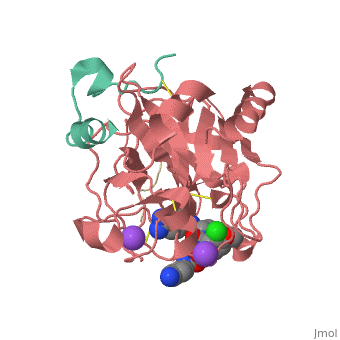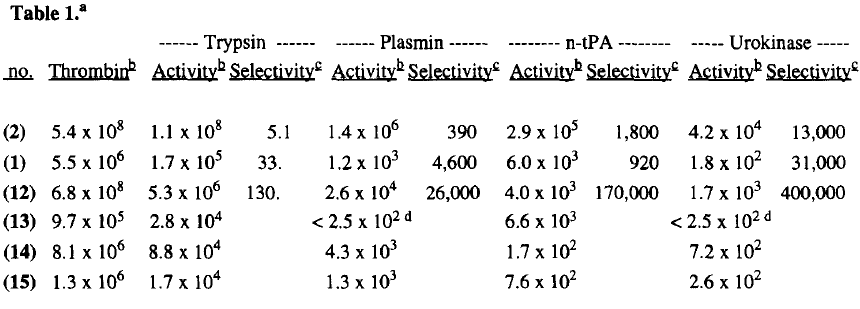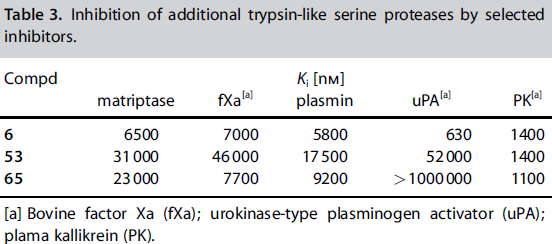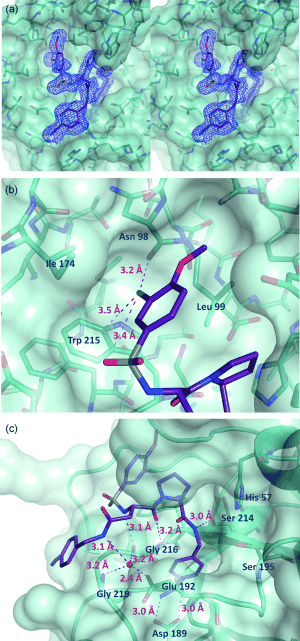Sean Swale/Human Thrombin Inhibitor
From Proteopedia
(Difference between revisions)
| Line 8: | Line 8: | ||
===Phe-Pro-p-amidinobenzylamine=== | ===Phe-Pro-p-amidinobenzylamine=== | ||
An early experiment to find a better thrombin inhibitor yielded a structure that was able to bond to the P1 and P2 sites of Thrombin effectively. In 1996 Lilly research laboratories created D-Phe-Pro-p-amidinobenzylamine by making improvements on the previous structure D-Phe-Pro-Agmatine. The new compound they created bonded to thrombin 130x more than it did to trypsin (also a serine protease), and it was highly selective of thrombin over fibrinolytic enzymes which break down fibrin clots. The inhibitor bound with Thrombin at rates 26,000x greater than with plasmin,<ref> http://voices.yahoo.com/what-fibrinolytic-enzymes-6186058.html?cat=68</ref>, 170,000x greater than with t-Pa, and 400,000x greater than with urokinase. | An early experiment to find a better thrombin inhibitor yielded a structure that was able to bond to the P1 and P2 sites of Thrombin effectively. In 1996 Lilly research laboratories created D-Phe-Pro-p-amidinobenzylamine by making improvements on the previous structure D-Phe-Pro-Agmatine. The new compound they created bonded to thrombin 130x more than it did to trypsin (also a serine protease), and it was highly selective of thrombin over fibrinolytic enzymes which break down fibrin clots. The inhibitor bound with Thrombin at rates 26,000x greater than with plasmin,<ref> http://voices.yahoo.com/what-fibrinolytic-enzymes-6186058.html?cat=68</ref>, 170,000x greater than with t-Pa, and 400,000x greater than with urokinase. | ||
| - | [[Image:1996 inhibitor rates.png|center|600px]] | + | [[Image:1996 inhibitor rates.png|center|600px|frame|<ref> M. R. Wiley, N. Y. Chirgadze, D. K. Clawson, T. J. Craft, D. S. GiffordMoore, N. D. Jones, J. L. Olkowski, L. C. Weir, G. F. Smith, Bioorg. Med. Chem. Lett. 1996, 6, 2387. http://www.sciencedirect.com/science/article/pii/0960894X96004428 </ref>]] |
Its selectivity was gained by binding its nitrogens on the benzamidine group by hydrogen bonding to Asp 189, and by fitting its benzamidine benzene into a hydrophobic pocket with Ser 214-Glu 217 and Asp 189-Glu 192 on the other side. The proline residue is in another hydrophobic pocket made up of His 57, Tyr 60A, Leu 99, and Trp 60D. The rest of this structure is unimportant on review of inhibitor 65 because only the amidinobenzylamine which occupies R1 and the proline which occupies the R2 sit are the same residues on inhibitor 65.<ref> M. R. Wiley, N. Y. Chirgadze, D. K. Clawson, T. J. Craft, D. S. GiffordMoore, N. D. Jones, J. L. Olkowski, L. C. Weir, G. F. Smith, Bioorg. Med. Chem. Lett. 1996, 6, 2387. http://www.sciencedirect.com/science/article/pii/0960894X96004428 </ref> | Its selectivity was gained by binding its nitrogens on the benzamidine group by hydrogen bonding to Asp 189, and by fitting its benzamidine benzene into a hydrophobic pocket with Ser 214-Glu 217 and Asp 189-Glu 192 on the other side. The proline residue is in another hydrophobic pocket made up of His 57, Tyr 60A, Leu 99, and Trp 60D. The rest of this structure is unimportant on review of inhibitor 65 because only the amidinobenzylamine which occupies R1 and the proline which occupies the R2 sit are the same residues on inhibitor 65.<ref> M. R. Wiley, N. Y. Chirgadze, D. K. Clawson, T. J. Craft, D. S. GiffordMoore, N. D. Jones, J. L. Olkowski, L. C. Weir, G. F. Smith, Bioorg. Med. Chem. Lett. 1996, 6, 2387. http://www.sciencedirect.com/science/article/pii/0960894X96004428 </ref> | ||
| Line 14: | Line 14: | ||
===P3 and P4 of Inhibitor 65=== | ===P3 and P4 of Inhibitor 65=== | ||
| - | [[Image:Inhibitor 65.png|center|400px]] | + | [[Image:Inhibitor 65.png|center|400px|frame|<ref> DOI: 10.1002/cmdc.201200292</ref> ]] |
Inhibitor 65 additionally has a P4 sulfonyl group with a methoxy group at the end of the residue. It sits in tight VanderWaals structure with the surrounding residues Leu 99, Tyr 60A, Arg 97, Glu 97, and Asn 98.Additionally, the chlorine points to the carbonyl oxygen of Asn 98 and there is a weak Cl-π bond with Trp 215. For the P3 residue, there the backbone of asparagine forms and anti parallel beta sheet with Gly 216. The alkylated asparagine’s NH binds to water which then connects to Glu 192, and the NH of Gly 219 and Gly 216. | Inhibitor 65 additionally has a P4 sulfonyl group with a methoxy group at the end of the residue. It sits in tight VanderWaals structure with the surrounding residues Leu 99, Tyr 60A, Arg 97, Glu 97, and Asn 98.Additionally, the chlorine points to the carbonyl oxygen of Asn 98 and there is a weak Cl-π bond with Trp 215. For the P3 residue, there the backbone of asparagine forms and anti parallel beta sheet with Gly 216. The alkylated asparagine’s NH binds to water which then connects to Glu 192, and the NH of Gly 219 and Gly 216. | ||
| - | [[Image:Thrombin1.gif|left|frame|300px|a) Stereo view of the complete inhibitor structure provided with its electron density in the active site of thrombin. Thrombin is shown with its solvent- accessible surface. b) The P4 sulfonyl residue is located in the aryl binding pocket. The chlorine atom points to the carbonyl oxygen of Asn 98 and accommodates a position above the indole moiety of Trp 215. The methoxy group perfectly fills the upper niche of the S3/4 pocket. c) The P3 side chain is directed into the solvent, where its amide NH binds via a bridging water molecule to Glu 192, Gly 216 and Gly 219.]] | + | [[Image:Thrombin1.gif|left|frame|300px|a) Stereo view of the complete inhibitor structure provided with its electron density in the active site of thrombin. Thrombin is shown with its solvent- accessible surface. b) The P4 sulfonyl residue is located in the aryl binding pocket. The chlorine atom points to the carbonyl oxygen of Asn 98 and accommodates a position above the indole moiety of Trp 215. The methoxy group perfectly fills the upper niche of the S3/4 pocket. c) The P3 side chain is directed into the solvent, where its amide NH binds via a bridging water molecule to Glu 192, Gly 216 and Gly 219.<ref> DOI: 10.1002/cmdc.201200292</ref> ]] |
</StructureSection> | </StructureSection> | ||
This is the <scene name='Sean_Swale/Human_Thrombin_Inhibitor/Thrombin_active_site/2'>active site</scene> of thrombin | This is the <scene name='Sean_Swale/Human_Thrombin_Inhibitor/Thrombin_active_site/2'>active site</scene> of thrombin | ||
| - | [[Image:1ppb-transparent.gif|right|500px]] | + | [[Image:1ppb-transparent.gif|right|500px|frame|Thrombin with serine residue visible.<ref>January 2002 Molecule of the Month by David Goodsell http://www.rcsb.org/pdb/101/motm.do?momID=25 </ref>]] |
==References== | ==References== | ||
{{reflist}} | {{reflist}} | ||
Revision as of 21:22, 15 November 2012
| |||||||||||
This is the of thrombin
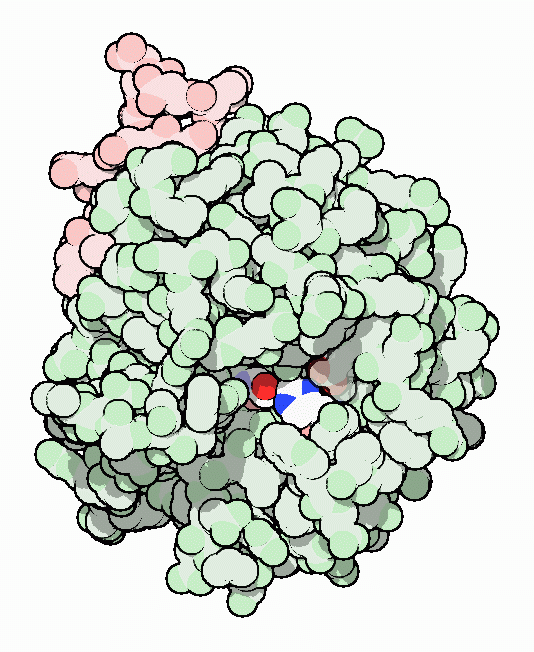
Thrombin with serine residue visible.[8]
References
- ↑ January 2002 Molecule of the Month by David Goodsell http://www.rcsb.org/pdb/101/motm.do?momID=25
- ↑ Steinmetzer T, Baum B, Biela A, Klebe G, Nowak G, Bucha E. Beyond Heparinization: Design of Highly Potent Thrombin Inhibitors Suitable for Surface Coupling. ChemMedChem. 2012 Aug 20. doi: 10.1002/cmdc.201200292. PMID:22907907 doi:10.1002/cmdc.201200292
- ↑ http://voices.yahoo.com/what-fibrinolytic-enzymes-6186058.html?cat=68
- ↑ M. R. Wiley, N. Y. Chirgadze, D. K. Clawson, T. J. Craft, D. S. GiffordMoore, N. D. Jones, J. L. Olkowski, L. C. Weir, G. F. Smith, Bioorg. Med. Chem. Lett. 1996, 6, 2387. http://www.sciencedirect.com/science/article/pii/0960894X96004428
- ↑ M. R. Wiley, N. Y. Chirgadze, D. K. Clawson, T. J. Craft, D. S. GiffordMoore, N. D. Jones, J. L. Olkowski, L. C. Weir, G. F. Smith, Bioorg. Med. Chem. Lett. 1996, 6, 2387. http://www.sciencedirect.com/science/article/pii/0960894X96004428
- ↑ Steinmetzer T, Baum B, Biela A, Klebe G, Nowak G, Bucha E. Beyond Heparinization: Design of Highly Potent Thrombin Inhibitors Suitable for Surface Coupling. ChemMedChem. 2012 Aug 20. doi: 10.1002/cmdc.201200292. PMID:22907907 doi:10.1002/cmdc.201200292
- ↑ Steinmetzer T, Baum B, Biela A, Klebe G, Nowak G, Bucha E. Beyond Heparinization: Design of Highly Potent Thrombin Inhibitors Suitable for Surface Coupling. ChemMedChem. 2012 Aug 20. doi: 10.1002/cmdc.201200292. PMID:22907907 doi:10.1002/cmdc.201200292
- ↑ January 2002 Molecule of the Month by David Goodsell http://www.rcsb.org/pdb/101/motm.do?momID=25
